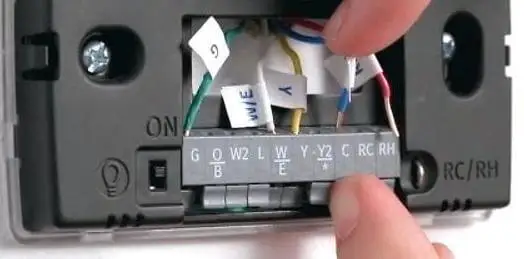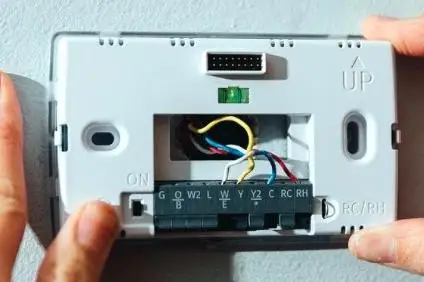How to Install Honeywell WiFi Thermostat without C Wire?
Many thermostats are enabled with wi-fi capabilities. This means the thermostat is able to connect to wifi through an app on your smartphone and you can control temperature with your tablet or smartphone.
.
Honeywell is a globally acclaimed and renowned name in millions of households. Honeywell thermostat is used to adjust a comfortable temperature in your home.
Before we head to the core of our content, we would like to share with our readers what really a “C” wire is. C wire is generally referred to as common wire. The common wire is the low-voltage power wire that WiFi thermostats want in order for their forward features to work. There are many homes who do not have a C wire installed because the old thermostat didn’t require one.
How to Check if Your Thermostat has a C Wire?
The most simple way to check if your thermostat has a c wire is to detach it. If there is a terminal named C is attached to it, then you have a “C” wire. To find out if you have a hidden c wire, check your furnace, there is a high chance that the common wire is hiding behind the wall. Now let’s check if you can install Honeywell thermostat without c wire.
How to Install Honeywell WiFi Thermostat without C Wire?

Step 1 : First, assess what you have in the box containing your new thermostat and set-up kit.
This is an accurate replication of what you should have in your box.Power off the heating, ventilation and air conditioner system before starting with your installation. Do this by adapting off the protagonist switch on your circuit box. This box can normally be found in your basement, attic, closet, or garage.
Step 2 : To start the installation process, power off the heating, ventilation and air conditioning system. You can do this by switching off the main switch of your circuit box. This box can usually be found in your basement, attic, or garage.
Step 3 : Make sure that your system is shut off.
Step 4 : Detach the former thermostat from the wall. No tool will be needed to pop off or unclip from the base.
Step 5 : You can take a picture of wires located on the back of your old thermostat for future reference.
Step 6 : Since it is already established that you do not have an ac wire. You will need to use the power extender kit.
The PEK requires certain wires for your system in order to work:
-
4 Wires: y/y1, R, G, W/w1
- 3 Wires: R, y/y1, and G
Step 7 : Take the necessary accessories such as power extender kit, tools, smartphone, wire labels and take them to your HVAC system.
Step 8 : Loosen the HVAC sheet to its power board and take a photograph of the wires that are connected to the power board. These might be taken for future references.
Step 9 : Identify the R, Y, G and W wires for support. Now, disconnect the R, Y, G and W wires from the power board, and re-connect them to the comparable grey terminal blocks positioned on the Power Extender Kit.
Step 10 : The next step is to connect the five wires. These five wires will be coming out of the PEK to the terminals on its identical control board.
Step 11 : Once you are finished with the previous process, attach your PEK inside the HVAC system. Adjoin your HVAC panel firmly and shift to your new Honeywell thermostat.
Step 12 : Now that you are following the thermostat, detach and identify the wires from the old thermostat using the design that was provided. Now. carefully remove your old thermostat cover.
Step 13 : Extract the wires through the hole positioned in the middle of the backplate.
Following this, connect the wires to the wall. It should be in this order:
R/Rc/Rh Rc, G/C, Y PEK

Step 14 : Push the thermostat back into its rear plate and snap it closed. You can now turn your HVAC system back on!
Step 15 : You have now successfully installed your Honeywell thermostat without the c wire.
If you have any more queries or doubts in your mind, you can send the details of your issues via email id. Our technicians will be glad to help you at any instant of time with immediate effect.
 Published by: Blaze
Published by: Blaze Brand: Honeywell Doorbell
Brand: Honeywell Doorbell Last Update: 2 weeks ago
Last Update: 2 weeks ago
 Related Blogs
Related Blogs
How to Install Honeywell Wireless Alarm?
How to Set Honeywell Thermostat Temperature?
Why is my Honeywell Thermostat Show up as Offline?
How to Reset Honeywell Thermostat WiFi?
Why is My Honeywell Thermostat not Working?

Trending Searches
-
How To Setup WiFi On Samsung Refrigerators? 31 Oct, 25
-
How to Fix Hikvision Error Code 153? - 2026 01 Oct, 25
-
Fix Shark Robot Vacuum Error 9 Easily (How) 26 Nov, 25
-
How to Set up Arlo Camera? 08 Jun, 25
-
How to Watch StreamEast on FireStick? 12 Nov, 25

Recent Post
-
How to Install Kodi on Amazon Fire Stick? 08 Dec, 25
-
How to Connect Govee Lights to Alexa? 08 Dec, 25
-
How to Connect Kasa Camera to WiFi? 07 Dec, 25
-
How to Fix Eero Blinking White Problem? 07 Dec, 25
-
How to Reset Eero? 07 Dec, 25
-
Why is My ADT Camera Not Working? 06 Dec, 25
-
Merkury Camera Wont Reset? Fix it 06 Dec, 25
-
How to Connect Blink Camera to Wifi? 06 Dec, 25
Top Searches in honeywell doorbell